The middle Palaeolithic period signifies the time between the first emergence of homo sapiens 300 000 years ago and the emergence of full behavioural modernity of homo sapiens 50 000 years ago.
Middle Paleolithic Timeline
315 000 years ago: approximate date of appearance of Homo sapiens (Morocco)
250 000 years ago: first appearance of Homo neanderthalensis
250 000 - 200 000 years ago: modern human presence in West Asia
210 000 years ago: modern human presence in south-eastern Europe
170 000 years ago: Humans wearing clothing
160 000 years ago: Homo sapiens idaltu
150 000 years ago: Peopling of Africa
120 000 years ago: Australian Aboriginal people were cooking on hearths. (Charcoal and burnt stone located within coastal dune sediments)
120 000- 75 000 years ago: Back migration from Southern Africa to East Africa
100 000 years ago: Earliest structures in the world (sandstone blocks in a semi-circle with an oval foundation) built in Egypt)
82 000 years ago: small perforated seashell beads from Morocco are the earliest evidence of personal adornment found in the world
70 000 years ago: earliest example of abstract art or symbolic art in Blombos Cave South Africa- stones engraved with grid and cross hatch patterns
67 000- 40 000 years ago: Neanderthal and Homo Sapien interbreeding
50 000 years ago: Earliest sewing needle found. Made and used by Denisovans
45 000- 43 000 years ago: European early modern humans
____________________________________________________________________________________________________________________________
Homo Sapiens
 Homo Sapiens evolved from Homo Heidelbergensis in East Africa around 300 000 - 350 000 years ago
The change in the skeleton of homo sapiens now allowed for increased cooperation and transport of resources.
The brain of the homo sapiens became more developed due to the change of metabolism and reduction of muscle strength of humans.
Homo sapiens noow have a unique cognitive ability compared to other archaic humans.
Homo Sapiens then began to spread across the world moving over the continent of Africa and eventually over hundreds of thousands of years across the world.
Evidence shows remains of homo sapiens in North Africa, South Africa and West Asia around 300 000 years ago.
Homo Sapiens evolved from Homo Heidelbergensis in East Africa around 300 000 - 350 000 years ago
The change in the skeleton of homo sapiens now allowed for increased cooperation and transport of resources.
The brain of the homo sapiens became more developed due to the change of metabolism and reduction of muscle strength of humans.
Homo sapiens noow have a unique cognitive ability compared to other archaic humans.
Homo Sapiens then began to spread across the world moving over the continent of Africa and eventually over hundreds of thousands of years across the world.
Evidence shows remains of homo sapiens in North Africa, South Africa and West Asia around 300 000 years ago.
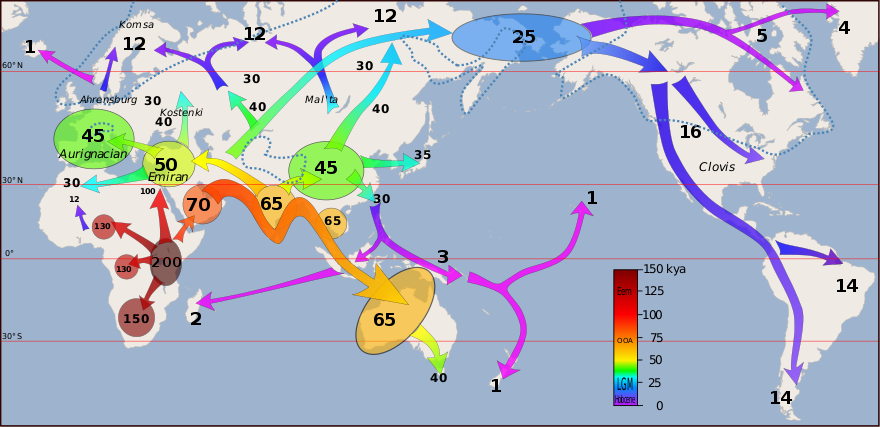 The oldest known homo sapiens outside of Africa was in Israel around 180 000 years ago. The dispersal of homo sapiens from
Africa would have happened around 220 000 years ago.
Stone tools have been found outside of Africa to signal the dispersals of homo sapiens. Stone tools were found in United Arab Emirates dating 80 000 years ago, India 74 000 years ago and Yemen 700 000 years ago.
More migrations through across Africa and into West Asia, South East Asia and Australia occurred during the middle paleolithic period.
The oldest known homo sapiens outside of Africa was in Israel around 180 000 years ago. The dispersal of homo sapiens from
Africa would have happened around 220 000 years ago.
Stone tools have been found outside of Africa to signal the dispersals of homo sapiens. Stone tools were found in United Arab Emirates dating 80 000 years ago, India 74 000 years ago and Yemen 700 000 years ago.
More migrations through across Africa and into West Asia, South East Asia and Australia occurred during the middle paleolithic period.
 During the middle paleolithic period homo sapiens have been found to perform burials which may have lead to developing of religious idealogy and concepts of an after life.
Early forms of artistic expression started during this time with creation of bracelets, beads, art rock, ochre used as body paint, sculpture and patterns found on elephant bones
Homo sapiens also learned to catch large fish and would hunt lage animals with specialized tools lead to group wide cooperation and more elaborate social organization.
Homo sapiens also begun to take part in long distance trade between groups for rare commodities like ochre and raw materials around 120 000 years ago.
Homo sapiens lived in small egalitarian band societies. Homo sapiens would take care of elderly members of their society. They would distribute resources like food and meat equally amongst their society to avoid famine and ensure a stable food supply.
Both men and women would hunt and scavenge for dead animals as well as gather plants and firewood.
During the middle paleolithic period homo sapiens have been found to perform burials which may have lead to developing of religious idealogy and concepts of an after life.
Early forms of artistic expression started during this time with creation of bracelets, beads, art rock, ochre used as body paint, sculpture and patterns found on elephant bones
Homo sapiens also learned to catch large fish and would hunt lage animals with specialized tools lead to group wide cooperation and more elaborate social organization.
Homo sapiens also begun to take part in long distance trade between groups for rare commodities like ochre and raw materials around 120 000 years ago.
Homo sapiens lived in small egalitarian band societies. Homo sapiens would take care of elderly members of their society. They would distribute resources like food and meat equally amongst their society to avoid famine and ensure a stable food supply.
Both men and women would hunt and scavenge for dead animals as well as gather plants and firewood.
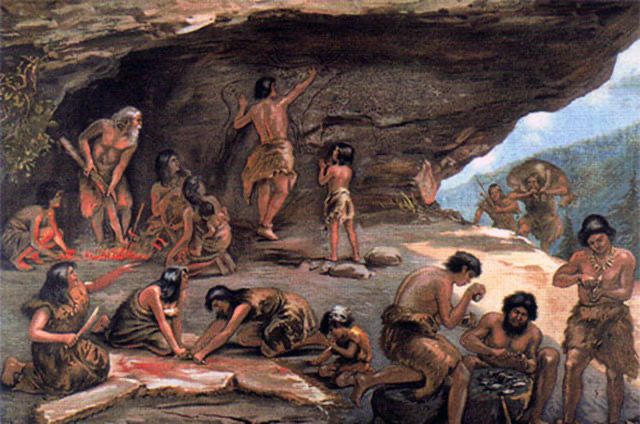 Gathering and hunting compromised most of the food supply for homo sapiens.
They did however begin to suppliment their diet with seafood and began smoking and drying meat to preserve and store it.
In some areas they could hunt large catfish with specialised barbed fishing points around 90 000 years ago.
Homo sapiens around Africa would also catch shellfish.
Cannibalism was also common in these societies because of food shortages or religious reasons.
Gathering and hunting compromised most of the food supply for homo sapiens.
They did however begin to suppliment their diet with seafood and began smoking and drying meat to preserve and store it.
In some areas they could hunt large catfish with specialised barbed fishing points around 90 000 years ago.
Homo sapiens around Africa would also catch shellfish.
Cannibalism was also common in these societies because of food shortages or religious reasons.
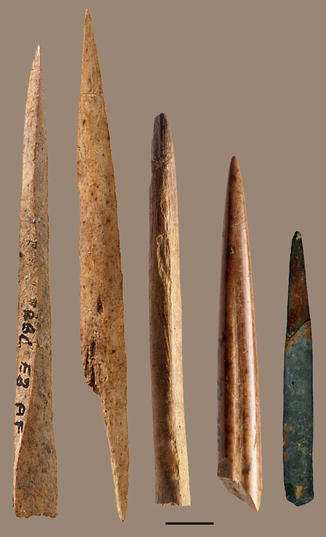
Bone tools found in South Africa that were shaped and scraped into shape. Used to pierce through soft materials like leather or shell beads.
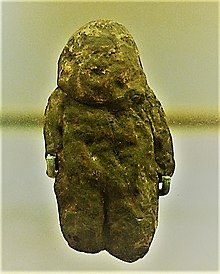
Venus of tan-Tan found in Morocco dates back to 300 000 to 500 000 years ago.
It is the earliest representation of human form.
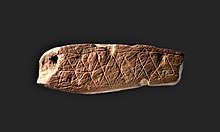
70 000- 100 000 year old engraved piece of ochre representing an eary abstract or symbolic depiction found in South Africa
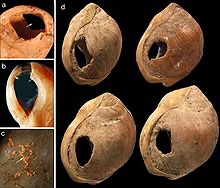
Shell beads made of dea snail shells found in South Africa.
The shells were deliberately pierced with a bone tool. The beads would have been strung on a cord and worn as personal ornament
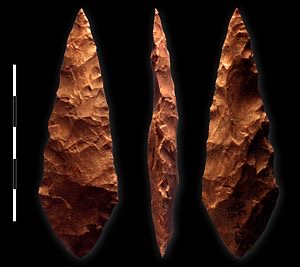
Around 200 000 years ago stone tool manufacturing spawned a tool making technique that was more elaborate than the acheulean techniques. More consistent and controlled and consistent flakes. This allowed for homo sapiens to create stone tipped spears by crafting sharp pointy stone flakes onto wooden shafts.
.jpg)
.JPG)
.jpg)
1. Mousterian tools made in North Africa and West Asia
2. Aterian tools made in North Africa and Oman.
3. Miscoquien tools made in Eastern Europe.
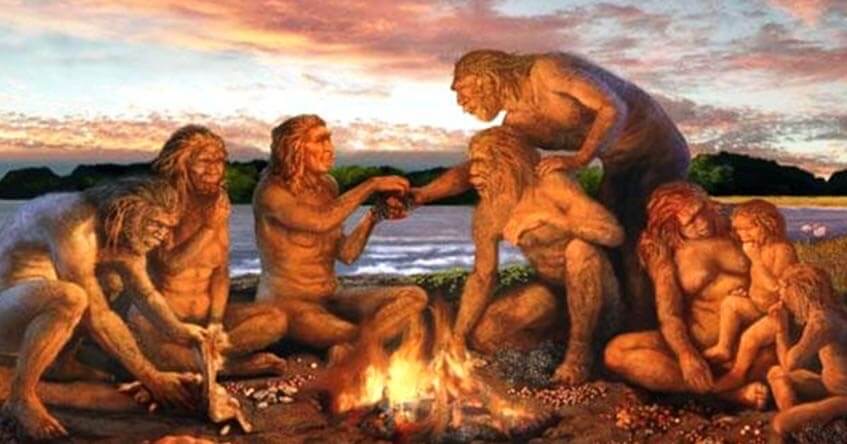
Fire became widespread for the first time during the middle paleolithic period. Homo sapiens began to cook their meat and food around 250 000 years ago.
____________________________________________________________________________________________________________________________
Denisovans
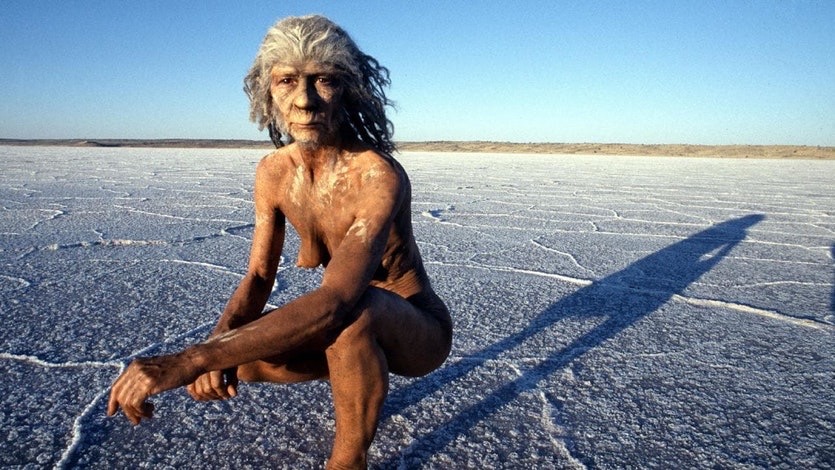 Denisovans first evolved from Homo Heidelbergensis across Asia around 100 000- 200 000 years ago
Stone tools have been found near Denisova fossils such as scrapers denticulate tools, notched tools, chizel like tools, and stone blades.
Tools from the upper paleolithic period was also found including bone tools and ornaments, a marble and ivory ring, an ivory pendant, a red deer tooth pendant an elk tooth pendant a chloritolite bracelet and a bone needle.
Some modern humans share the same genomes as Denisovans which means there was interbreeding between Denisovans with Homo Sapiens and Neanderthals.
Aboriginals, New Guineans, Polynesians, Fijians, east Indonesians and Mamanwans share Denisovan DNA.
Denisovan DNA has also been found within Chinese, Japanese and Dai genomes.
Denisovans first evolved from Homo Heidelbergensis across Asia around 100 000- 200 000 years ago
Stone tools have been found near Denisova fossils such as scrapers denticulate tools, notched tools, chizel like tools, and stone blades.
Tools from the upper paleolithic period was also found including bone tools and ornaments, a marble and ivory ring, an ivory pendant, a red deer tooth pendant an elk tooth pendant a chloritolite bracelet and a bone needle.
Some modern humans share the same genomes as Denisovans which means there was interbreeding between Denisovans with Homo Sapiens and Neanderthals.
Aboriginals, New Guineans, Polynesians, Fijians, east Indonesians and Mamanwans share Denisovan DNA.
Denisovan DNA has also been found within Chinese, Japanese and Dai genomes.
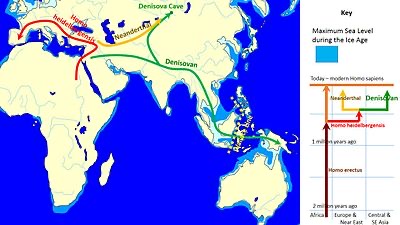
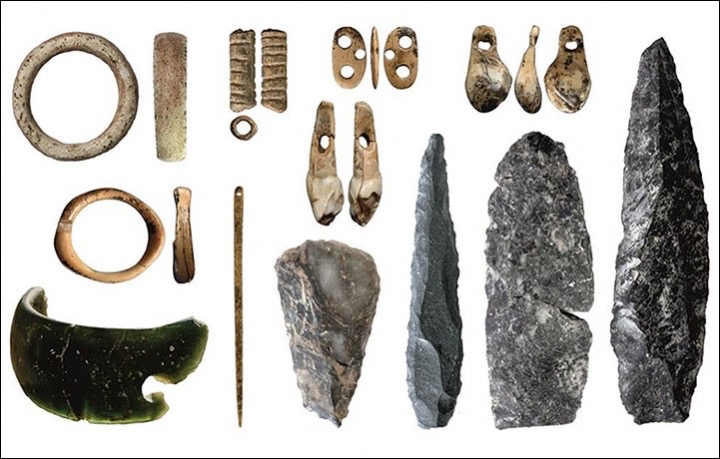
Tools and jewellery made by the Denovians that date between 156 000 years ago and 44 000 years ago
____________________________________________________________________________________________________________________________
Neanderthals
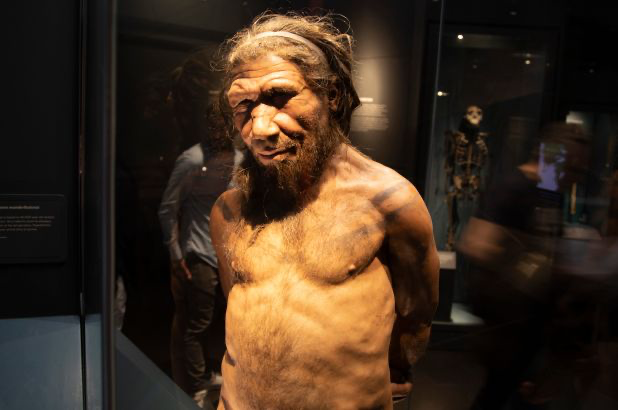 Neanderthals evolved from Homo Heidelbergensis in Europe and Asia around 300 000 years ago.
Neanderthals were omnivores with their diet mainly consisting of protein. From this we can tell that they would hunt their food.
By looking at the quality of the stone tools of Neanderthals we can tell that they were good at expert cognition- observational learning and practice that relies on long term procedural memory. Strong cognitive abilities could have also led to strong social ties and a degree of rationality.
However their toolmaking didn't change much over the hundreds of thousands of years that they existed, which may indicate a reduced capacity for thinking by analogy and less working memory.
Due to similarities to modern human's hyoid we can predict that Neanderthals were capable of speech
They may have made birch tar to use as an adhesive by dry distillation of birch bark. They could then use this tar as a backing on small domestic stone tools
During the middle paleolithic period Neanderthals may have practiced cannibalism and excarnation (removal of flesh) in order to survive due to changes in climate affecting the availability of animals to hunt.
Few neanderthals would have lived past the age of 35.
Neanderthals evolved from Homo Heidelbergensis in Europe and Asia around 300 000 years ago.
Neanderthals were omnivores with their diet mainly consisting of protein. From this we can tell that they would hunt their food.
By looking at the quality of the stone tools of Neanderthals we can tell that they were good at expert cognition- observational learning and practice that relies on long term procedural memory. Strong cognitive abilities could have also led to strong social ties and a degree of rationality.
However their toolmaking didn't change much over the hundreds of thousands of years that they existed, which may indicate a reduced capacity for thinking by analogy and less working memory.
Due to similarities to modern human's hyoid we can predict that Neanderthals were capable of speech
They may have made birch tar to use as an adhesive by dry distillation of birch bark. They could then use this tar as a backing on small domestic stone tools
During the middle paleolithic period Neanderthals may have practiced cannibalism and excarnation (removal of flesh) in order to survive due to changes in climate affecting the availability of animals to hunt.
Few neanderthals would have lived past the age of 35.
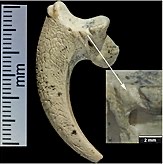
Neanderthal jewelry made of a white tailed eagle claw that has a man made ridge dating around 130 000 years old
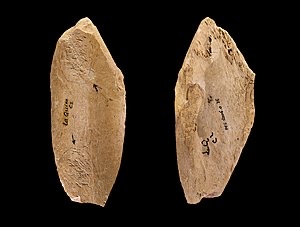 Neanderthal tool retoucher on a bone shaft that is used to modify stone tools.
Neanderthal's toolkits were more simple than those from homo sapiens in the upper paleolithic period.
The tools they make are known as mousterian and were produced using soft hammer percussion from materials such as bones, antlers and wood.
Their tools consisted of stone flakes and task specific hand axes.
Neanderthal tool retoucher on a bone shaft that is used to modify stone tools.
Neanderthal's toolkits were more simple than those from homo sapiens in the upper paleolithic period.
The tools they make are known as mousterian and were produced using soft hammer percussion from materials such as bones, antlers and wood.
Their tools consisted of stone flakes and task specific hand axes.
_Neanderthal_site,_Crimea,_Micoquian_industry_dated_to_between_38_and_43_cal_kyr_BP.jpg)
Neanderthal work of art with symbolic incisions decorating the raven bone dated around 38 000- 43 000 years old
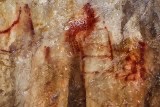
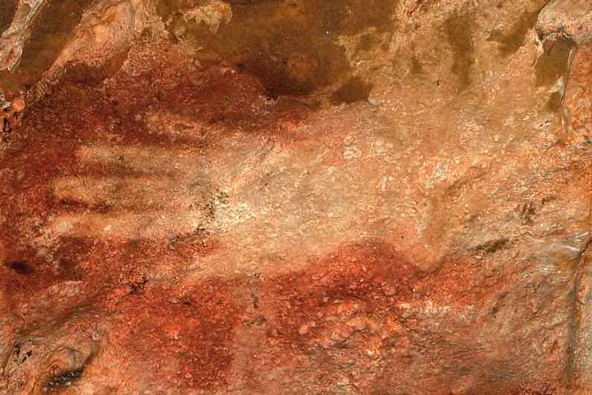 Red ochre designs painted on the walls of a 2 different caves in Spain by Neanderthals 64 000 years ago.
This is known to be the oldest art in the world.
The paintings were made 20 000 years before homo sapiens had set foot in Europe.
Neanderthals may have been capable of symbolic thought and human rationality.
There are a number of claims of Neanderthal art, adornment and structures.
However a lot of these practices interlaps with homo sapien prescence in Europe.
Red ochre designs painted on the walls of a 2 different caves in Spain by Neanderthals 64 000 years ago.
This is known to be the oldest art in the world.
The paintings were made 20 000 years before homo sapiens had set foot in Europe.
Neanderthals may have been capable of symbolic thought and human rationality.
There are a number of claims of Neanderthal art, adornment and structures.
However a lot of these practices interlaps with homo sapien prescence in Europe.
_(9420310527).jpg)
This cave bear femur bone may have been turned into a flute by Neanderthals around 43 000 years ago. That would make this the world's oldest musical instrument.
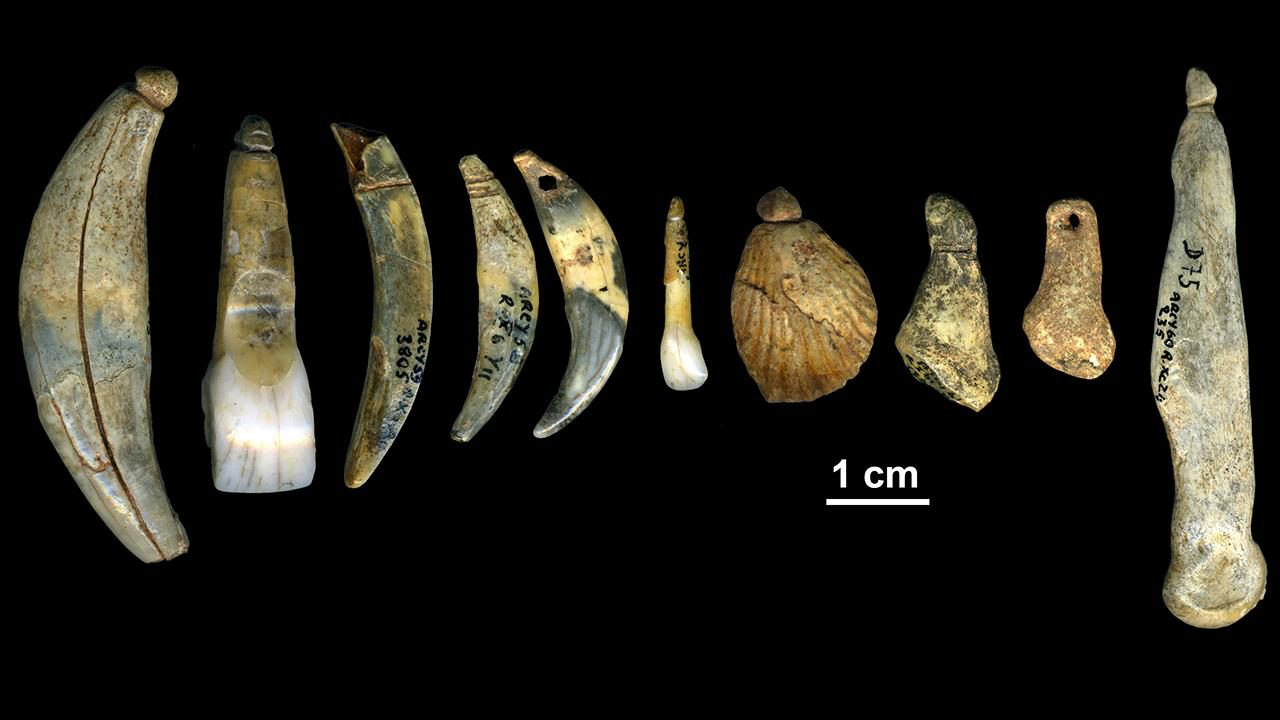
These Chatelperronian beads made of animal teeth, shells and ivory may have been made by the Neanderthals.
 Genetic analysis of body louse shows that they diverged from head louse 170 000 years ago.
Since they live in clothing it shows evidence that humans began wearing clothing around this time.
Sewing needles have been dated to around 50 000 years ago from Denisova caves and associated with other human species.
Genetic analysis of body louse shows that they diverged from head louse 170 000 years ago.
Since they live in clothing it shows evidence that humans began wearing clothing around this time.
Sewing needles have been dated to around 50 000 years ago from Denisova caves and associated with other human species.
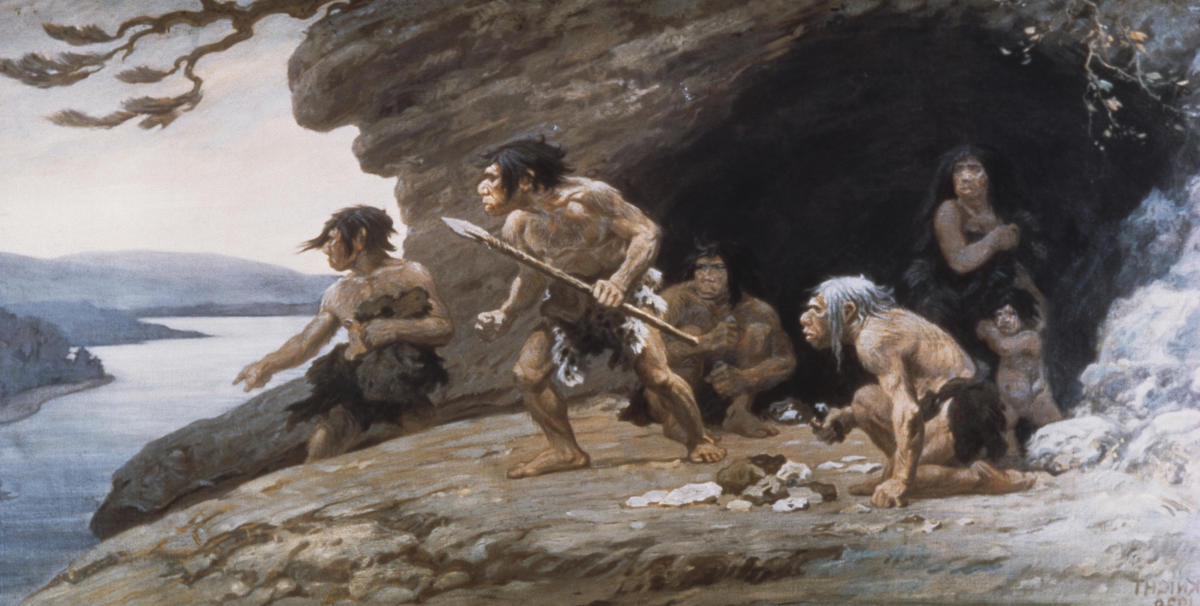 Neadertal would take care of elderly members of their society.
During this period they began to catch shellfish for food around 110 000 years ago
Neadertal would take care of elderly members of their society.
During this period they began to catch shellfish for food around 110 000 years ago
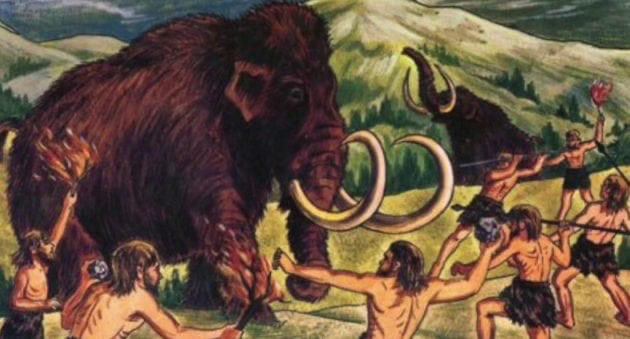 Neanderthal made wooden spears but it is unknown if they were used as projectiles or as thrusting spears.
Neanderthals hunted large game animals by ambushing them and attacking them with melee weapons such as thrusting spears rather than attacking with projectile weapons.
Neanderthal made wooden spears but it is unknown if they were used as projectiles or as thrusting spears.
Neanderthals hunted large game animals by ambushing them and attacking them with melee weapons such as thrusting spears rather than attacking with projectile weapons.
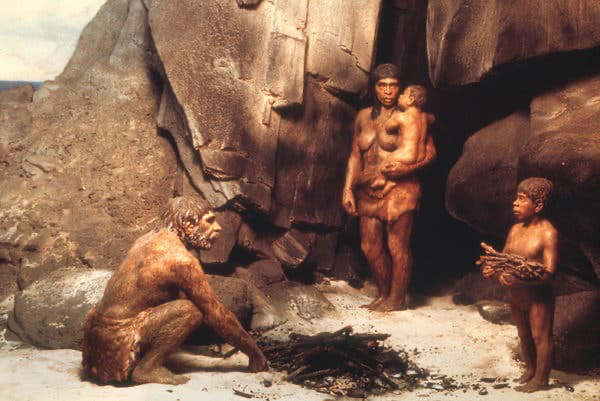 Neanderthals would use fire on occasion but it is not certain if they were able to produce it.
They may have used manganese dioxide powder to accelerate the combustion of wood.
Neanderthals would use fire on occasion but it is not certain if they were able to produce it.
They may have used manganese dioxide powder to accelerate the combustion of wood.
____________________________________________________________________________________________________________________________
Homo Erectus
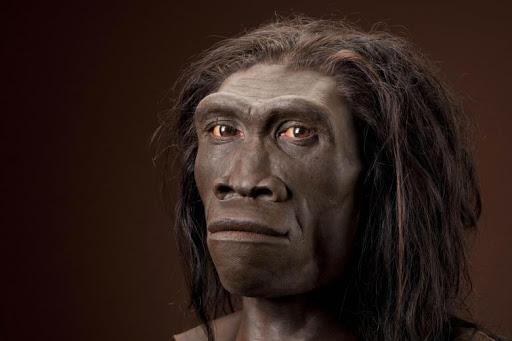 Homo erectus evolved from Homo Habilis in Africa around 2m years ago.
Many different sub species of erectus have been found across Africa, Europe and Asia.
Homo erectus made stone tools, considered to be the earliest human ancestor capable of starting fires, speech, hunting an gathering in coordinated groups, caring for injured and sick group members and making art.
Homo erectus survived for over a million years and became extinct around 50 000 years ago.
Homo erectus evolved from Homo Habilis in Africa around 2m years ago.
Many different sub species of erectus have been found across Africa, Europe and Asia.
Homo erectus made stone tools, considered to be the earliest human ancestor capable of starting fires, speech, hunting an gathering in coordinated groups, caring for injured and sick group members and making art.
Homo erectus survived for over a million years and became extinct around 50 000 years ago.
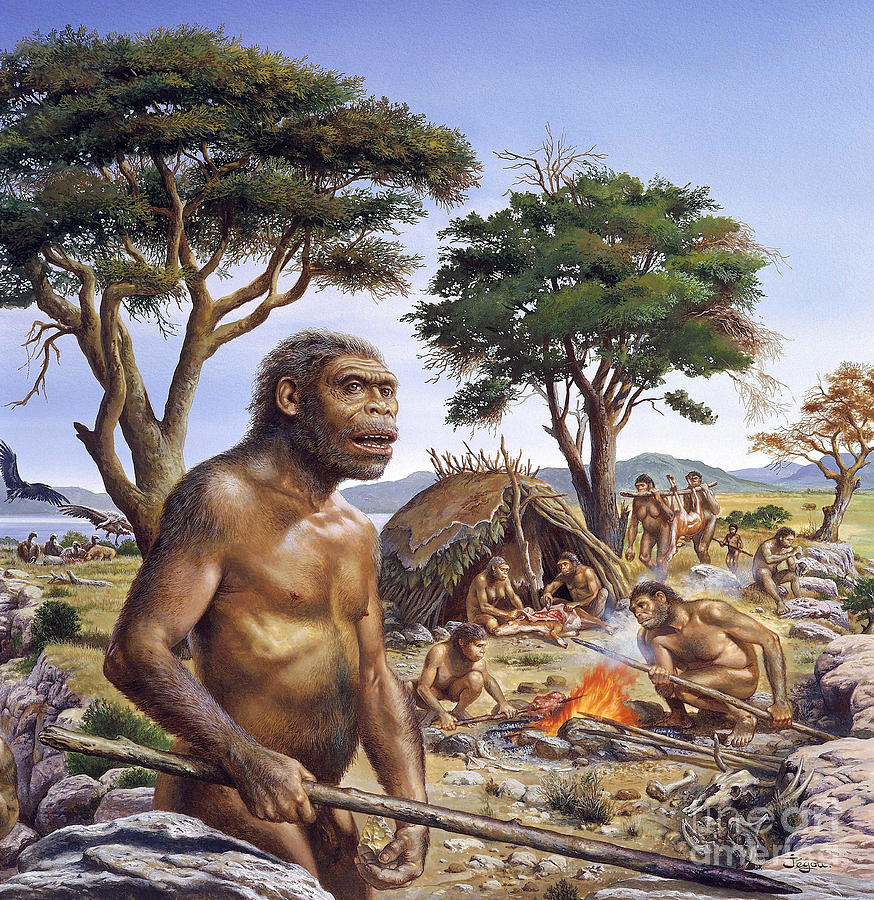
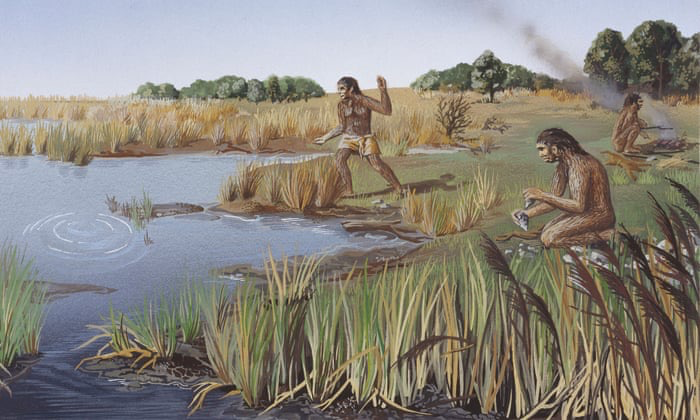 Homo erectus may have been the first humans to use rafts to travel over bodies of water
They were probably the first hominin to live in a hunter gatherer small banded society and were socially more like modern humans than earlier ancestors.
They would have hunted in coordinated groups, using complex tools and caring for weak companions.
They may not have been capable of producing sounds comparable to modern human speech but likely communicated in a proto language and non verbal communication.
Homo erectus may have been the first humans to use rafts to travel over bodies of water
They were probably the first hominin to live in a hunter gatherer small banded society and were socially more like modern humans than earlier ancestors.
They would have hunted in coordinated groups, using complex tools and caring for weak companions.
They may not have been capable of producing sounds comparable to modern human speech but likely communicated in a proto language and non verbal communication.
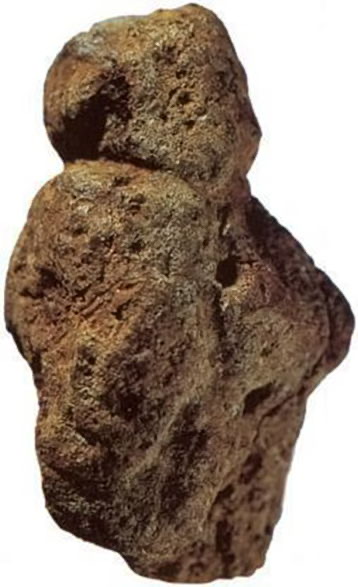 Venus of Berekhat Ram is the oldest sculture in the world and is dated to be anywhere around 230 000 years old to 700 000 years old.
Because of its age it could have been made by homo erectus.
Venus of Berekhat Ram is the oldest sculture in the world and is dated to be anywhere around 230 000 years old to 700 000 years old.
Because of its age it could have been made by homo erectus.
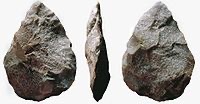 Homo erectus are credited to inventing the Acheulean stone tool industry that followed on from the Oldowan industry.
They were the first to make hand axes out of stone used for butchering.
This shows they had the ability of foresight and could plan steps ahead in order to create them.
Homo erectus are credited to inventing the Acheulean stone tool industry that followed on from the Oldowan industry.
They were the first to make hand axes out of stone used for butchering.
This shows they had the ability of foresight and could plan steps ahead in order to create them.
.jpg) An engraved shell with geometric markings could possibly be evidence of the earliest art making dating back to 546 000-436 000years ago.
This could show evidence of symbolic thinking which is associated with modern cognition and behaviour.
An engraved shell with geometric markings could possibly be evidence of the earliest art making dating back to 546 000-436 000years ago.
This could show evidence of symbolic thinking which is associated with modern cognition and behaviour.
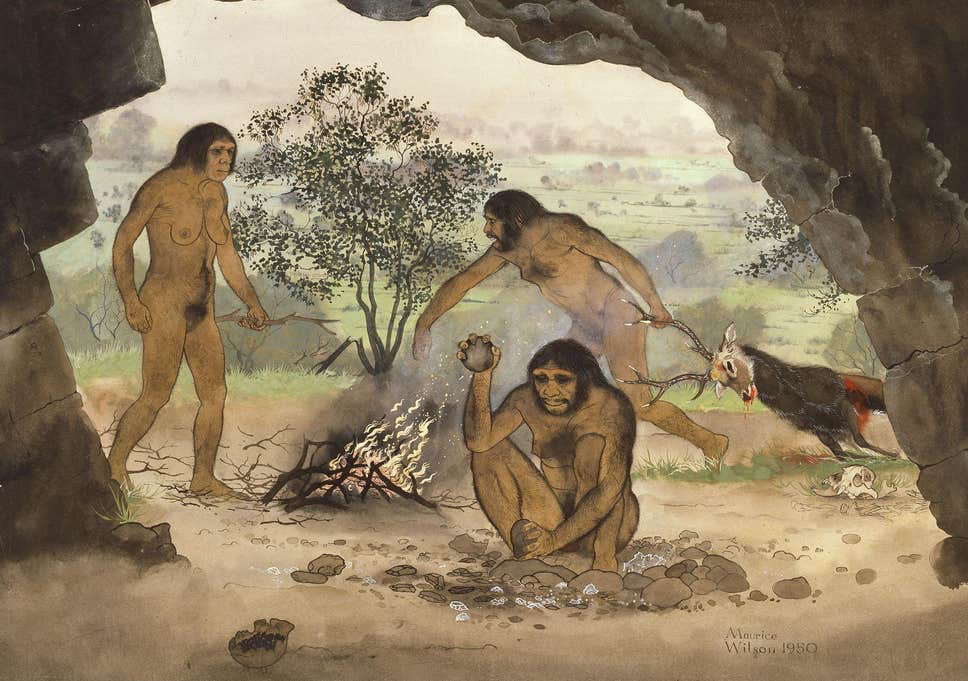
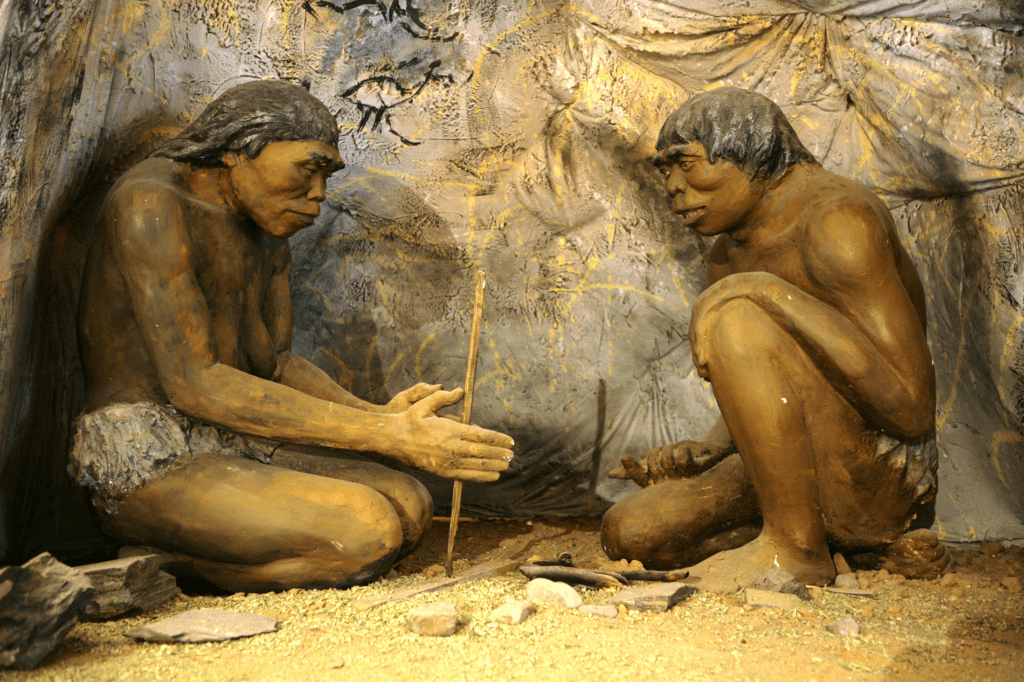 Evidence shows that Homo Erectus could control fire between 790 000 and 690 000 years ago.
They may have also been cooking their food around 500 000 years ago.
Evidence shows that Homo Erectus could control fire between 790 000 and 690 000 years ago.
They may have also been cooking their food around 500 000 years ago.
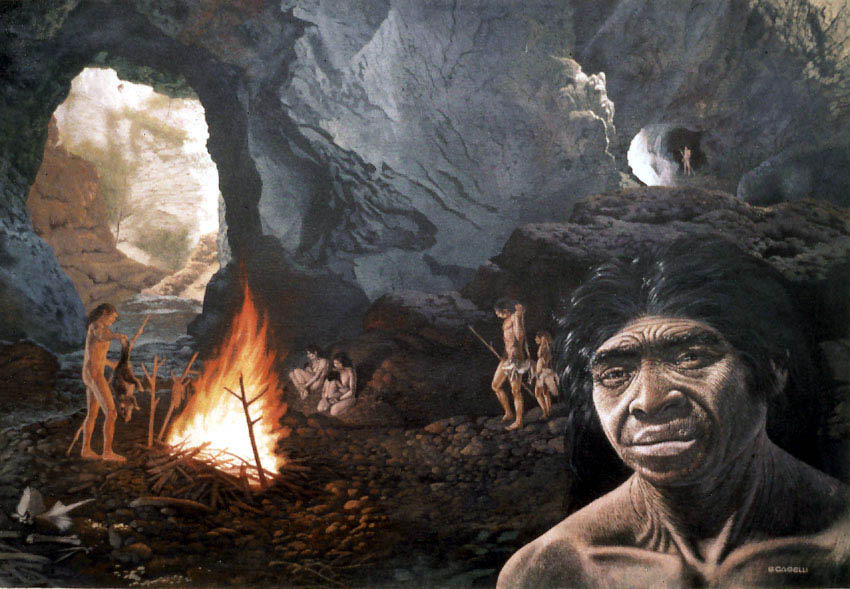
____________________________________________________________________________________________________________________________
Homo Floresiensis
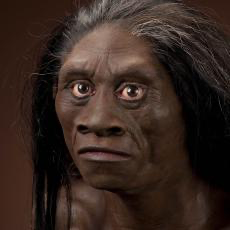 Homo floresiensis evolved from homo erectus.
They have existed in Indonesia 100 000 years ago.
Their ancestors lived on the island around 1m years ago
Homo Floresiensis became extinct around 50 000 years ago.
Homo floresiensis evolved from homo erectus.
They have existed in Indonesia 100 000 years ago.
Their ancestors lived on the island around 1m years ago
Homo Floresiensis became extinct around 50 000 years ago.
 Homo floresiensis were small statured humans.
Their ancestors were the homo erectus who became stranded on the island. Pressures unique to the island caused them to become smaller over time and evolved into homo floresiensis.
The nature of the environment in Flores and the limited food sources provides strong evidence for the evolution of Homo Floresienses.
When small populations become separated changes can occur very quickly- and in this case reduced energy requirements with dwarfing are a response to this.
Homo floresiensis were small statured humans.
Their ancestors were the homo erectus who became stranded on the island. Pressures unique to the island caused them to become smaller over time and evolved into homo floresiensis.
The nature of the environment in Flores and the limited food sources provides strong evidence for the evolution of Homo Floresienses.
When small populations become separated changes can occur very quickly- and in this case reduced energy requirements with dwarfing are a response to this.
 Homo floresiensis implements were also found.
They created stone tools from flint like pebbles.
They created knife like flakes for cutting tasks and stout edged cobble cores that were suitable heavy chopping tools.
Homo floresiensis implements were also found.
They created stone tools from flint like pebbles.
They created knife like flakes for cutting tasks and stout edged cobble cores that were suitable heavy chopping tools.
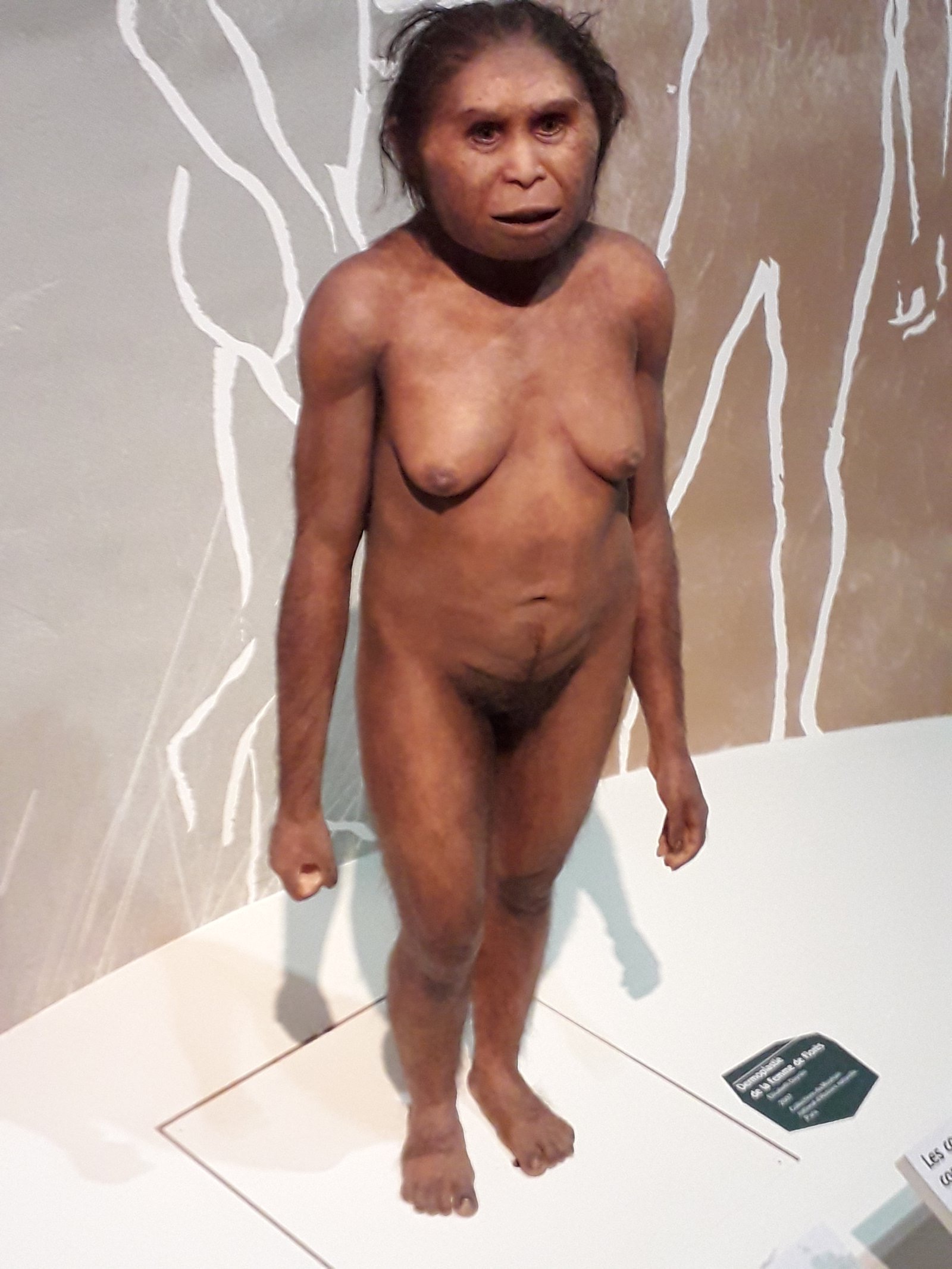 Homo Floresiensis may have been able to use fire as remains of charred bones have been found that indicate Homo Floresiensis was able to control fire for cooking.
The Floresiensis shared the island with pygmy elephant, giant rats and large lizards. There have been cut marks found on pygmy elephant bones which indivate that Floresiensis were hunting and eating them.
Homo Floresiensis may have been able to use fire as remains of charred bones have been found that indicate Homo Floresiensis was able to control fire for cooking.
The Floresiensis shared the island with pygmy elephant, giant rats and large lizards. There have been cut marks found on pygmy elephant bones which indivate that Floresiensis were hunting and eating them.









.jpg)
.jpg)







_Neanderthal_site,_Crimea,_Micoquian_industry_dated_to_between_38_and_43_cal_kyr_BP.jpg)


_(9420310527).jpg)










.jpg)







